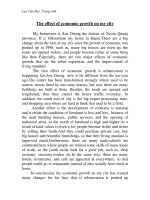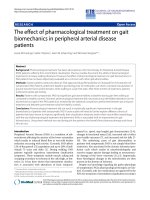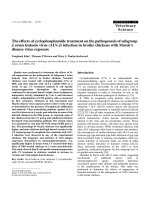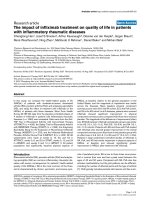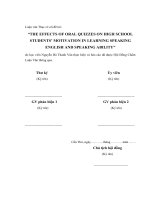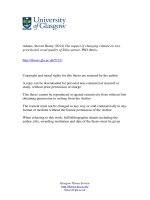Studying the capability of greywater treatment on site by using laterite material
Bạn đang xem bản rút gọn của tài liệu. Xem và tải ngay bản đầy đủ của tài liệu tại đây (1.43 MB, 27 trang )
MINISTRY OF EDUCATION
AND TRAINING
MINISTRY OF AGRICULTURE
AND RURAL DEVELOPMENT
WATER RESOURCES UNIVERSITY
KHUONG THI HAI YEN
STUDYING THE CAPABILITY OF GREYWATER
TREATMENT ON SITE
BY USING LATERITE MATERIAL
Major: Water resources engineering
Code: 62580212
DOCTORAL THESIS ABSTRACT
HANOI, 2016
The research is completed in Water Resources University, Hanoi, Vietnam
Advisor 1: Assoc. Prof., Dr. PHAM Thi Minh Thu
Advisor 2: Assoc. Prof., Dr. NGUYEN Thi Kim Cuc
Reviewer 1: Dr. TRINH Xuan Lai, Vietnam Water Suply and Sewerage Association
Reviewer 2: Assoc. Prof., Dr. NGUYEN Ngoc Dung, Ministry of Construction
Reviewer 3: Prof., Dr. TRAN Huu Uyen, Expert of Water Treatment
The doctoral thesis has been presented at Water Resources University,
Hanoi, Vietnam
At 8.30 on 30 th October 2016
Finding the doctoral thesis in:
- National Library
- Library of Water Resources University
INTRODUCTION
1.
Urgency of research:
Greywater accounts for 69%1 of domestic wastewater flow and contaminant
concentrations lower than the blackwater but most of the pollution parameters
are not meet up the Regulation to discharge directly into the environment.
Wastewater treatment technology such as SBR, A2O only effective in treatment
of organic matter but not effective in treatment of nitrogen to reach the require
level; and often apply to big wastewater treatment plants. Need to research a
suitable processing solution with the scale and characteristics of greywater as
the criteria for: simple operation, high nitrogen removal efficiency, area of land
occupied is less and towards sustainable technologies.
Laterite is local materials, available in many areas in Vietnam country. Laterite
is form structure, contains many kinds of minerals such as clay (kaolinite,
bentonite), the hydroxides of iron, the hydroxides aluminum, zeolite, brucite,
gibbsite, goethite2 ... are substances that the polarity inside the water, with the
ability to exchange ions, in the crystal structure, manies void and large specific
surface area. Therefore the laterite is easy to join the adsorption, ion exchange,
electrostatically with some pollution matter and having the potential of
wastewater treatment field. However, these ability is reduced with time,
together with the clog process because the developed of microbial membranes.
This problem can improve with using laterite according multilayer soil layering
engineering3.
Thesis "Studying the capability of greywater treatment on site by using laterite
material" was conducted to determine the ability to treat the greywater of
laterite with multilayer layering engineering. The success of the studing is
opened up a new direction in the use of local materials, environmentally
friendly to treat greywater on-site; contribute to reduce pressure on the
Barnes, D và cộng sự, Water and Wastewater Engineering Systems, Pitman Books Ltd., ed. London, 1981.
Nyle C.Brandy, The nature and the Properties of soils, 2nd ed.: ISBN: 9780130167637, 2001.
3
T.Masunaga et al, "Characteristics of wastewater treatment using a Multi Soil Layering system in relation to wastewater
contamination level and hydrolic loading rates," Soil Science and Plant Nutrition, pp. 123-125, 2007.
1
2
1
wastewater treatment plants, the length of urban pipelines and environmental
pollution. The treated of greywater can be used for irrigation, control the
distribution domestic buildings and saving water resources for the future.
1.1
The aim of research
Determination of greywater characteristics from some buildings in Hanoi city;
Explaination of the principle of removing the main pollutants out of greywater
by using laterite with multi soil layering engineering; Determination of
decomposition rate coefficients of BOD5, COD and NH4+ -N. The number of
laterite layer is calculated based on these coefficients; Successful greywater
treatment from building by using laterite with Multi Soil Layering engineering
and the treated effluent meet up the National Regulations (QCVN
14:2008/BTNMT; QCVN 08-MT:2015/BTNMT).
1.2
1.2.1
Object and scope of research
Object of research
Multi Soil Layering engineering is using laterite as main material for greywater
treatment from buliding in Ha noi city.
1.2.2
Scope of research
Greywater from some buildings in Hanoi city; Multi Soil Layering engineering
with natural laterite and heat denaturation laterite.
1.3
Method of research
Using main method of research such as: investigation and sample collection,
inheritance, lab analysis, lab model, pilot model, statistical method.
1.4
Content of research
Determination of greywater characteristics from some buildings in Hanoi city;
Studying the capacibilityof greywater treatment through lab Multi Soil
Layering models; Application the lab result for designing the pilot (MSL6-PL)
for greywater treatment onsite from B5-Yen Thuong building.
1.5
The scientific and practical significances
2
1.5.1
Scientific significances
- Determination of decomposition rate coefficients of BOD5, NH4+ -N and
COD. The number of laterite layer is calculated based on these coefficients.
- Determination of efficiency, explaination of the principle of removing the
main pollutants out of greywater by using laterite with multi soil layering
engineering;
1.5.2
Practical significances
Applying for greywater treatment from buildings in Hanoi city. The quality of
effluent meet up the National Regulation QCVN 14:2008/BTNMT; QCVN
08:2008/BTNMT.
1.6
The structure of the thesis
The structure of the thesis beyond the preamble; conclusions and
recommendations; lists of articles were published; reference section; annexes;
Thesis is presented in threes chapters, including:
Chapter 1. Overview of the research problems
Chapter 2. Basic of scientific, material and studying method for greywater
treatment by using laterite with Multi Soil Layering Engineering.
Chapter 3. The research results of greywater treatment on-site by using laterite
with Multil Soil Layering engineering.
CHAPTER 1 : OVERVIEW OF THE RESEARCH PROBLEMS
1.1
Greywater
Greywater is part of the waste water without treatment and collected from
showers, lavabol, tub, kitchen sink… (except toilet and urine sink) and
accounted for 69% of domestic wastewater. The pollution concentrations of
organics and nutiens such as BOD5, COD, N, P are lower than the
concentration of black wastewater. The pollution concentrations in greywater
depends on habit and level of living, traditional, economic conditions,
management, methods of greywater collection and source of drainage etc each
area.
3
Greywater is treated by chemical – physical, biological, mechanical method.
These are many researchs of greywater in the world, the greywater is treated to
seek of resources water saving in future or reducing of environmental
pollution. Some case studies such as M. Halalsheh, 2008 (Jordan); Peter L.M.
Veneman and Bonnie Stewart, 2002 (USA); Elmitwalli et al, 2000
(Netherlands). In Vietnam, Stefania Paris and Celine Schlapp, 2010; N.V.Anh
et al, 2012; K.T.H. Yen et al, 2014 studies greywater, the results show that most
of the contaminants concentrations exceed the allowable value specified in the
QCVN14: 2008/BTNMT. Therefore, the greywater are required to treat before
being discharged into the environment.
1.2
1.2.1
Laterite and Application for wastewater treatment.
Useful minerals for contaminant treatment in greywater
These the mineralogy of laterite are clay (kaolinite, bentonite), the hydroxides
of iron, alumina, zeolite, diatomite, and has been characterized by the topology
of the form -O-H H-O-H-O loose. Group OH- ions easily combined with
oppositely in retail gas oxygen atoms in this link may be involved in the
process of cellular respiration of the microorganism; the basic structural unit
consisting of a tetrahedron made of Si and O, the octahedral blocks from OHand metal cations Al3+, Fe3+. Al3+ ions, Fe3+ is likely linked to the opposite ion
is the glue sound in wastewater4.
1.2.2
The reseaches of laterite applycation in wastewater treatment field
These are a lot of researches which using laterite as absortion material for
wastewater treatment. Such as R. B. Wood and C. F. Mc Atamne, 1996 (USA);
Avinash M et al, (India); Mitali Sarkar et al, 2006 (India); Saynor MJ &
Harford, 2010 (USA); Yu Xiaohong et al, 2009 (China); Felix Udoeyo et al,
2010 (USA); Liang Zhang et al, 2011 (China); I.M.M Ranhman et al, 2008
(Japan). In Vietnam, Nguyen Thi Hang Nga, 2014; Tran Hong Con, 2010;
Dang Duc Truyen, 2011 research on laterite and heat denaturation to made filter
material for water treatment. The result show that laterite can treat the fluoride,
Đỗ Thị Vân Thanh, "Laterit - đá ong hóa và sự thoái hóa đất của một số tỉnh vùng đồi Trung du miền Bắc
Việt Nam," 1995
4
4
heavy metal with high performance; the organics concentration is reduced but
creating of residues, it’s the cause to make flog inside the multi soil layering
system. Most of researches processed inside the laboratories with assuming
pollution matter then different distance when application in real.
1.3
Multi Soil Layering
Multi Soil Layering is using multi- layers of material with original from soil,
arranged in a certain sequence to treat the contaminants inside wastewater.
T.Matsunaga research and develop the Multi Soil Layering from the 1990s in
Japan as a wastewater treatment solution with low cost (Fig 1.12).
Influent
Soil units: These units are made from soils,
complete the decomposition process of
organics, nutrients base on the activities of
exotic, aerobic and anerobic bateria.
Lining: Using of material such as activated
carbon, zeolite, gravel for adsorption and
decomposition the contaminants base on the
adsorption capactity of material and
activities of materia.
Effluent
Fig 1.12: Structural diagram of multi soil layering
In this thesis used the results of some laboratory researches, such as: With the
soil unit are thick then effect to treat nitrogen but making the clog quickly;
With soil unit are thin then effect to treat organics but not effective for nitrogen;
With the soil units are thickness and narrow then the perfomance of
contaminants are average but can work well with high hydraulic loading, less
clog and the hydraulic retention time inside the multi soil layering is inversely
related to the hydraulic loading5. The pollution levels of contaminants inside
wastewater input less effection to treatment performance of suspended solid,
organics and nitrogen but more effective to phosphorus; Hydraulic loading is is
inversely related to performance of phosphorous; The arrangement of the
5
Sato K., Masunaga T., Inada K., Tanaka T., Arai Y., Unno S. and Wakatsuki T., "The development of high
speed treatment of polluted river water by the multi-soil-layering method, Examination of various materials
and structure," .Jpn J. Soil Sci. Plant Nutr., vol. 200, 2005.
5
material structure is meaningful and high treatment performance when
hydraulic loading is less than or equal 2.000 L/m2.day. When the wastewater
loading is beyond 2.000 L/m2.day then the structure arrangement of material is
not effective much to the treatment performance6. Until now, there is not any
research of application the multi soil layering engineering in Vietnam.
CHAPTER 2 : BASIC OF SCIENTIFIC, MATERIAL AND STUDYING
METHOD FOR GREYWATER TREAMENT BY USING LATERITE
WITH MULTI SOIL LAYERING ENGINEERING
2.1
Basic of scientific for greywater treatment by using laterite with
multi soil layering engineering
- The adsorption reaction occurs with the adsorption kinetic model. The ability
of the contaminants adsorption of laterite was evaluated using the Langmuir
equation (2-1):
(2-1)
- Organics, nutrients inside the greywater are removed through the action of
available microorganisms. Model of decomposition Monod is used to determine
the biodegradation coefficients and is written as follows7:
(2-2)
2.2
Material
The main material are laterite with dimension LxBxH = 30x15x5 cm and heat
denaturation laterite at 9500C with diameter 1-3mm.
2.3
2.3.1
Studying Method
Laboratory model
Laboratory models made of stailess steel, cube with dimension Length x Wide
x High = 15x50x(33-76) cm; inside made of 3,4,5,6,7 laterite layers and the
laterite unit is stagger between up and next down layers, like brick wall (MSL3,
6
Xin CHEN et al, "Effect of structural difference on wastewater treatment efficiency in Multil Soil Layering
systems: Relationship between soil mixture," Soil Science and Plant Nutrition, vol. 53, p. 206–214, 2007.
7
Lawrence A.W. and McCarty P.L., "A unified basis for biologycal treatment design and operation," Journal
of the Sanitary Engineering Division , American Society of Chemical Engineers, vol. 96, p. 757, 1970.
6
MSL4, MSL5, MSL6, MSL7); row distance is 3 cm, column distance is 2,5 cm
and insertion by heat denaturation laterite with diamter 1-3 mm; the gravel is
bottom of laboratory madel with diameter 4-6 cm, thickness of this support
gravel is 10 cm (Fig 2.14).
MSL7
MSL6
MSL5
MSL4
MSL3
Fig 2.14: Lab model of Multi Soil Layering
After removing the rubbishs, the greywater is distributed with the 2.000
littre/m2.day hydraulic loading to every laboratory models. The samples are
took at influent and efflent point of every model.
2.3.2
Model of pilot
Pilot model was designed based on the coefficient ks, K; treated water meet up
the value specified in QCVN 14:2008/BTMT(B) - National technical regulation
on domestic wastewater (value in domestic wastewater as being discharged into
water resources not used for the purpose of domestic water supply - with water
quality equivalent to that in column B1 of the national technical Regulation on
surface water quality) and QCVN 08-MT:2015/ BTNMT(B1) - National
Technical Regulation on surface water quality (surface water used for irrigation
purposes). After caculation then choice pilot model with 6 laterite layer (MSL6PL) and dimensions LxBxH = 0,95x0,5x0,68m for greywater treatment from
7
some apartments of the B5-Yen Thuong. MSL6-PL made of force glass, 1.2
thickness and placed in a steel frame inside with 6 natural laterite layers
arranged in staggered layers; Grades 3 cm apart and rows spaced 2.5 cm and
inserted laterite heat denaturation granular 1-3mm diameter; bottom gravel
layer 4-6 cm thick support diameter 10 cm. Gray waste water collected from the
B5-Yen Often garbage removal and lead to a 200-liter tank, then pumped into
the tissue quantification Fig with hydraulic load of 2,000 liters / m2.ngay.
Below the water sampling valve for later processing. The system is operated
continuously for 24 hours/day. Samples were taken at the beginning of the in
and out of scale Fig 10 days (Fig 2.18)
4
5
14
6
13
7
1
10
8
9
2
i=1
5%
11
3
12
Fig 2.18: Diagram of pilot model of MSL6-PL
Notice: 1. Influent of greywater; 2. Storage tank 200littres; 3. Pump; 4. Flow meter; 5.
Weir of distribution; 6. Distribution system; 7. Laterite; 8. Heat laterite; 9. Gravels; 10.
Collection of treated; 11. Storage; 12. Pipeline; 13. Over flow; 14. Dosing equipment
8
2.3.3
Laboratory analysis
Samples were analyzed in the laboratory with Standard Method and equivalent
Vietnamese Standards.
2.3.4
Statistical Analysis
The results is average anlytical values plus standard deviation of all time
analytics. The relationship between laterite layers and concentration of
contaminants is expressed through the linear regression equation or logarithmic
equations and assessed according to the coefficient of determination (R2).
CHAPTER 3 : THE RESEARCH RESULTS OF GREYWATER
TREATMENT ON-SITE BY USING LATERITE WITH MULTI SOIL
LAYERING ENGINEERING
3.1
Characteristics of greywater from buildings in Hanoi city
The results of laboratory analysis: the average concentration of contaminants
inside the greywater samples which collection from some buildings (CT5B –
Me Tri, 11 floor condominiums of Duc Giang, building of B5 Yen Thuong) at
Table 3.1 showed that the concentration of organics, nitrogen, suspended solids
total exceeded many time value which certificated in Regulation
QCVN14:2008/BTNMT (B)- National technical regulation on domestic
wastewater. Therefore, the greywater forced to treat before discharge into the
environment.
Table 3.1: Characteristics of greywater from some building in Hanoi city
Regulation QCVN
Notice
No Paramters Unit
Average
14:2008 (B)
1
pH
2
COD
3
BOD5
COD: BOD5
4
TSS
5
PO43--P
6
T-P
3PO4 -P/ T-P
mg/L
mg/L
mg/L
mg/L
mg/L
(%)
8,13±0,12
234,10±67,2
121,87±21,24
1,97:1
258,20±29,8
2,60±0,54
4,89±0,65
52,7±5,54
9
5-9
50
100
10
-
Meet up
Not meet up
Not meet up
Meet up
-
7
NH4+-N
8
T-N
+
NH4 -N/ T-N
BOD5/T-N
mg/L
mg/L
(%)
-
8,90±1,26
17,73±1,21
49,93 ±4,65
6,87:1
10
-
Meet up
In Vietnam, the characteristics of greywater from buildings are: the ratio COD:
BOD5 = 1.97 (lower than 2 in Isarel and 4,4 in england) and suitting to use bio
treatment method; the ratio BOD5:TN = 6,8 – It’s enough cacbon to occur the
denification. The concentration of TN is 17,73 mg/L and higher than 13 mg/L
for house in Vietnam. Amonium accounts for 49,9% for TN and phosphat
accounts for 52,7% for TP of greywater. Accodding H.Henze8, this
characteristic of greywater is equal dilute level.
3.2
3.2.1
The research results on laboratory model of Multi Soil Layering
The moving flow inside laboratory model
After 1st day, the total water column is reduced about 30cm, equivelent 30%
total of influent flow, because water come inside the material. From 2 nd da, the
total water column is reduce less about 1,5% and mostly have no change from
3st day, it show that the material is saturation and the flow of effluent is stable.
Thus the reduction just occurred mainly in the first 2-3 days of water soaked
into the material and forming saturated state. The reduction of flow is
proportional to the number of laterite layers in the system.
3.2.2
The quality changing of greywater through laterite layers with multi
soil layering
3.2.2.1 Organics (BOD5, COD)
The performance of BOD5 reached from 77,22% to 90,60%, the concentration
of effluent reduced below 20 mg/L for greywater; The performance of BOD5
reached from 70,50% to 80,33%, the concentration of effluent reduced below
10mg/L for dilute greywater (Fig 3.3, Fig 3.4).
8
Harremoes Henze and La Cour Jansen Arvin , "Wastewater Treatment: Biological Process," 1996.
10
Concentration of
BOD5 (mg/L)
120
100
80
60
40
20
0
NTNB
Nước thải sau MSL3
Nước thải sau MSL5
Nước thải sau MSL7
Nước thải sau MSL4
Nước thải sau MSL6
Nước thải đầu vào
Concentration of
BOD5 (mg/L)
Fig 3.3: Concentration of BOD5 before and after treatment of greywater
60
50
40
30
20
10
0
Nước thải đầu vào
Nước sau MSL4
Nước sau MSL6
Nước sau MSL3
Nước sau MSL5
Nước sau MSL7
NTPL
Fig 3.4: Concentration of BOD5 before and after treatment of dilute greywater
The performance of BOD5 BOD5 proportional to the number of laterite layers
and BOD5 concentrations in influent. The concentrations of BOD5 droped
fastest through 3 - 4 upper laterite layer.
After 6-7 laterite layers then COD concentration of effluent is stable. For
greywater, the performance of COD reached 45,72%- 71,61%, COD
concentration of effluent reduced below 30mg/L (Fig 3.5, Fingure 3.6).
Concentration of
COD (mg/L)
200
160
120
Nước thải đầu vào
Nước thải sau MSL3
Nước thải sau MSL4
NTNB
80
40
0
Fig 3.5: Concentration of COD before and after treatment of greywater
11
Concentration of
COD (mg/L)
200
160
120
Nước thải đầu vào
Nước thải sau MSL3
Nước thải sau MSL4
NTPL
80
40
0
Fig 3.6: Concentration of COD before and after treatment of dilute greywater
The removal process of cacbon occurs mainly in aerobic conditions, in the
process of microbial growth. The more down of laterite layer, the amount of
cacbon is reduced; the dissolved oxygen too but cacbon can link with oxigen
from O-H-O-H-O loose structure and creat the peroxite as form below:
This peroxite have a haft of active oxigen. Grace of catalase and peroxydasecan
enzyme, alive cells of microorganisms resolution active peroxide and use
oxygen for oxidation others persistent organics which it’s difficult to decay.
Therefore, the performance of organic removal is increased.
3.2.2.2
Nitrogen and nitrogen compounds
The treatment performance NH4+-N increased from 66.49% to 94.58% and
from 79.68% to 89.91% respectively for the original greywater and dilute
greywater and proportional to the number of laterite layers. NH4+-N
concentration decreased rapidly from 8.71 mg/L to 2.84 mg/L after 3rd laterite
layer and to 2.19 mg/L after the 4th laterite layer; decreased slowly after the 6 th,
7thlaterite layer respectively are 0.58 mg/L and 0.46 mg/L.
Especially the NH4+-N treatment performance of dilute greywaterranged
79.68% - 82.48% and of greywaterranged 66,49% and 74.16%, the treatment
performance of dilute greywater is higher than performance of greywater; After
5thlaterite layer, the treatment performance has not much different but after 6 th
laterite layer the NH4+-N treatment performance of greywateris higher than
12
dilute greywater. The NH4+-N concentration of effluent is below 4 mg/L –
greywater and is below 2 mg/L – dilute greywater with all laboratory models.
The NH4+-N concentration decreased because: transformation from NH 4+-N to
N2and NO3--N, NO2--N (N2 can exit to sky, its’s accounting for 80-85%) and
other part of NH4+-N be adsorted bygoethite and hemathite of laterite (Fig 3.7,
Fig 3.8).
Concentration of
NH4+ -N (mg/L)
20
15
Nước thải vào
Nước thải sau MSL4
Nước thải sau MSL6
Nước thải sau MSL3
Nước thải sau MSL5
Nước thải sau SML7
NTNB
10
5
0
Concentration of
NH4+ -N (mg/L)
Fig 3.7: Concentration of NH4+-N before and after treatment of greywater
10
8
6
Nước thải vào
Nước thải sau MSL4
Nước thải sau MSL6
Nước thải sau MSL3
Nước thải sau MSL5
Nước thải sau MSL7
NTPL
4
2
0
Fig 3.8: Concentration of NH4+-N before and after treatment of dilute greywater
The inorganic carbon in CO2, HCO3-, CO32-are foods for autotrophic
microbiologyand effect on the transformation of NH4+-N to oxidized into NO3(in this equation, the oxygen as electron acceptors and N as electron giving); 1g
NH4+-N need4,25 gO2 and 7.14 gCaCO3–ratio of oxygen needed for BOD
oxidation is 1: 1. Grade of specical structure of laterite, 6 atom of oxygen
around an atom Fe3+ and Al3+ creat the loose link of O-H-O-H-O. Therefore ion
NH4+ conected with OH-, atom of oxgen can join to the oxidation of autotrophic
to oxidized NH4+ to nitrite and nitrat. Additionally, the pH value of greywater is
7.71 then iron exist mainly in the form of Fe (OH)3. Thismatter has property
13
of cations when pH <7, and has property of annion when pH> 7.1 (isoelectric
point at pH = 7.1). Therefore inside the greywater envinronment, the NH4+ is
adsorted by Fe (OH)3 as reaction below:
Fe(OH)3-+ NH4+ FeNH4(OH)3
(3-1)
The process of transformation from NH4+-N to NO2- and NO3- cause to changed
these concentration inside the grey waste water and dilute greywater (Table
3.2).
Table 3.2: Concentration of NO2-, NO3- before and after treatment
Symbols Concentration of NO2-, NO3- of Concentration of NO2-, NO3- of
greywater (NTNB)
dilute greywater (NTPL)
CoutNO2- (mg/L)
CoutNO2- (mg/L)
Cout NO3- (mg/L)
1,14±0,44
1,49±0,12
MSL3
2,17 ±0,68
Cout NO3(mg/L)
1,18±0,26
MSL4
2,42±0,84
1,84±0,42
0,51±0,21
0,64±0,09
MSL5
1,87±0,6
2,41±0,34
0,14±0,11
1,16±0,12
MSL6
0,78±0,29
2,69±0,33
0,06±0,07
1,54±0,13
MSL7
0,75±0,22
2,49±0,33
0,06±0,07
1,62±0,23
The result show that nitrit formed inside 1st -3rd of laterite layers; the maximum
concentration of nitrit is maximum at 4th laterite layer and starting of reducing
from 5th to 7th of laterite layer. After 6th -7th of laterite layer, the concentration
of nitrit extremely reduced, even below the measurement limits of equipment.
The concentration peak of nitrat after 6th laterite layer with greywater and after
7th laterite layer with dilute greywater.For pH > 5 always- it’s value of
greywater, the ion of NO3--N, NO2--N can be adsorted by laterite because these
anion linked to ion Fe3+ (goethite) and Al3+ (gibsite).
The removing processes of amonium, nitrit, nitrat aremain cause to reduce the
T-N of greywater by biodegradation of microorganisms and adsortion of
laterite. The removing performance of nitrogen proportional to the number of
laterite inside the system, reaching 46.67% - 70.31% and 44.85% - 57.29%
respectively for the greywater and dilute greywater.
14
Phosphorus (T-P) and phosphate (PO43—P)
3.2.2.3
The removing processes of phosphate is main cause to reduce the T-P of
greywater by adsortion of laterite and using as nutrient of microorganism. The
removing performance of phosphate reached 87,31%-98,84% - greywater and
89,01%-97,61% - dilute of greywaterrespectively for the number of laterite
from 3 to 7 inside system. The phosphate of effluent droped very low, even
below the detection limit of the equipment - it demonstrated the phosphate
removal potential of laterite is very high (Fig 3.18Fig , Fig 3.19). The
phosphate was adsorted by geothite as reaction as below:
Fe-OH+ HPO42- + H = Fe-OPO32- +H2O
(3-2)
The Fe-OPO32- holded on surface of laterite, it’s cause to reduce the
concentration of phosphate.
Apart from phosphorus being adsorbed by laterite, other part of phosphorus
being adsorbed by microorganisms. Phosphorus is nutrient for development of
microorganisms, it’s necessy for aerobic microorganisms as reaction as below:
C2H4O2 + 0,16NH4+ + 1,2O2 + 0,2PO43- → 0,16C5H7O2 +
(3-3)
1,2CO2 + 0,2(HPO3) + 0,44OH- +1,44H2O
Estimate the loading of phospho being adsorted by microorganism as below:
While: A: concentration of COD (mg/L)
x: the quality of COD be digested by
Concentration of
PO43--P (mg/L)
microorganism (mg/L)
4,0
3,5
3,0
2,5
2,0
1,5
1,0
0,5
0,0
Nước thải vào
Nước thải sau MSL4
Nước thải sau MSL6
Nước thải sau MSL3
Nước thải sau MSL5
Nước thải sau MSL7
NTNB
Fig 3.18: Concentration of PO43--P before and after treatment of greywater
15
Concentration of
PO43--P (mg/L)
2,0
Nước thải vào
Nước thải sau MSL4
Nước thải sau MSL6
1,5
Nước thải sau MSL3
Nước thải sau MSL5
Nước thải sau MSL7
NTPL
1,0
0,5
0,0
Fig 3.19: Concentration of PO43--P before and after treatment of greywater
The removing performance of T-P increased proportional to the number of
laterite layers and the reducing of T-P is lower than PO43-P. The performance of
T-P reached range 48,13%-97,19% and 61,04%-95,04% respectively for
greywater and dilute of greywater; these performance reached more than 90%
after 6th laterite layer, this performance is high.
3.2.3
Dertermination of decay rate coefficient of organics (BOD5, COD)
and removal rate coefficient of nitrogen (NH4+-N)
3.2.3.1 Dertermination of decay rate coefficient of organics (BOD5, COD)
and removal rate coefficient of nitrogen (NH4+-N)
The decay ratio of organics (ks) determinated by equation of T. Pfeiffer, R.
Malone:
(3-4)
Post award above equation by logarithm and non-linear regression all
experience results of laboratory model. The result expressed at Fig 3.23, Fig
Remaining
concentration BOD5
(mg/L)
3.24, Table 3.17.
80
BOD5
NTNB
NTPL
Expon. (NTNB)
Expon. (NTPL)
60
y = Co.e-0.34x
R² = 0.969
y = Co.e-0.21x
R² = 0.876
40
20
0
0
1
2
3
4
5
6
7
8
Laterite layers
Fig 3.18: Relation between concentration of BOD5 and laterite layers
16
Remaining
concentration of
COD (mg/L)
150
COD
100
y = Co.e-0.18x
R² = 0.915
50
NTNB
NTPL
Expon. (NTNB)
Expon. (NTPL)
y = Co.e-0.22x
R² = 0.835
0
0
1
2
3
4
5
6
7
8
Laterite layers
Fig3.19: Relation between concentration of COD and laterite layers
Table 3.17: Organics decay coefficient of greywater and dilute greywater
No
Parameters
1
BOD5
2
COD
3.2.3.2
Influent
concentration ( mg/L)
76,71
34,72
136,43
66,61
Coefficient ks
(layer-1)
0,34
0,21
0,22
0,18
R2
0,969
0,876
0,835
0,915
Determination of removal rate coefficient of nitrogen.
The amonium is removed through biodegradation and adsortion processes
inside the multi soil layering system. The biodegradation ratio expressed with
Monod equation; the adsortion ratio expressed with Langmuir equation. The
process of biodegradation and adsorption occurs parallel to each other and
defined by the equation below:
r = rsinh học + rhấp phụ= k1.(C0 C) + k2.(C0 C)
(3-5)
Logarit of both sides are result as below:
Kt =
For dertermination of K then post award of the function
(3-6)
(depend
on t – the number of layer); and the slope of graphs is value of K. The result
expressed at Fig 3.25, Table 3.18.
17
lnCo/C
4
NTNB
NTPL
3
y = 0,4014x
R² = 0,9698
2
y = 0,3828x
R² = 0,8859
1
0
0
1
2
3
4
5
6
7
8
Laterite layers
Fig 3.25: Relationship between
and laterite layers
Table 3.18: Determination of removal rate coefficient of amonia (NH4+-N)
No
Parameters
1
NH4+-N
3.2.3.3
Influent
concentration (mg/L)
7,82
3,04
Coefficient K (layer-1)
R2
0,401
0,382
0,969
0,885
The mechanic of removing the main pollutants out of greywater by
using laterite with multi soil layering engineering.
The chemical and physical processes and complex biological place in aerobic
zone (not flooded) and the anaerobic (waterlogged). The contaminants are
removed through filtering mechanism, adsorption, decomposition of organic
matter and nitrogen in wastewater to form complexes gray are retained in a
grade laterite or food for microorganisms; most of the processes of pollutants in
gray wastewater occurs in the upper layer of soil in aerobic conditions.
3.3
Pilot results of greywater treatment from B5-Yen Thuong bulding
on-site.
The pilot model caculated base on the characteristic of greywater of influent
and effluent, flow, coefficient ks, K. Caculation and choosing of pilot model
which having 6 laterite layers (MSL6-PL) with dimension LxBxH =
0,95x0,5x0,68 m. This pilot treat greywater from some apartments in B5-Yen
Thuong.
Start up process of pilot: From 1 to 13 first day of period is time to create
microorganisms; about 14-19 next days is the time for microorganisms
18
development; stabilization process after the 19th day onwards. Timing for start
Concentration
(mg/l)
up pilot requires at least about 13 days and showed in Fig 3.27.
8
NH4+-N
NO2NO3-
6
4
2
0
1
3
5
7
9
11 13 15 17 19 21 23 25
Time (day)
Fig 3.27: The concentration variation of NH4+-N, NO2-, NO3- during start up
process of pilot
The result of greywater treatment showed at Table 3.5 as below:
Table 3.3: Concentration and performance of greywater from B5-YenThuong
building
No Parameters Unit
Greywater
Performance QCVN14:2008
1
2
3
4
5
6
7
pH
COD
BOD5
TSS
PO43--P
T-P
NH4+-N
mg/L
mg/L
mg/L
mg/L
mg/L
mg/L
Influent
7.37±0.84
139.40±32.66
92.90±28.88
164.83±52.87
2.11±0.82
3.92±1.53
7.05±3.03
8
T-N
mg/L
13.34±5.32
3.3.1.1
(%)
/BTNMT (B)
Effluent
6.95±0.65
39.63±15.63
13.66±10.57
15.94±56.34
0.14±0.069
1.06±0.46
0.62±0.48
71.3±10.13
88.4±9.06
89.9±5.51
91.8±4.07
72±7.92
90.33±7.10
5-9
50
100
10
10
4.37±1.97
67.76±5.63
-
Variation of pH
Same the results of research on laboratory model, the trending of greywater’s
pH is decrease; the largest decrease happended at the date 04/21/2014 (from
8.80 to 7.90) and smallest decrease happened at the date of 19.07.2014 (from
5.50 to 5.42). The results of pilot studying is similar laboratory models. The
variation of pH is large with higher pH of input.
3.3.1.2
Organics (BOD5, COD)
19
Concentration of
BOD5 (mg/L)
The removal performance of BOD5 reached 61.9% -90.6% (mean 88.4%) and
tended to increase over time. During the the time of practice: the concentration
of BOD5 ranged 25-45mg/L, the performance of BOD5 increased from 47,9%
to 61% in the first month – but still this performance is lower than the results
of other month; from next month the BOD5 concentrations droped below 15
mg/L. The average removal performance of the COD of model pilot reached
71.4 ± 10.13%, it’s higher than the results obtained for the MSL6 (laboratory
model) was 64.5 ± 4.6% (Fig 3.28, Fig 3.29).
500
400
300
200
100
80
Nước thải trước xử lý
Nước thải sau xử lý
Hiệu suất xử lý (%)
60
40
100
20
0
0
Concentration of
COD (mg/L)
Fig 3.28: Concentration of BOD5 before and after treatment of greywater
500
100
400
Nước thải trước xử lý
Nước thải sau xử lý
Hiệu suất xử lý (%)
300
200
100
80
60
40
20
0
0
Fig 3.29: Concentration of COD before and after treatment of greywater
The average COD concentration of effluent reached 39.63 ±15.6mg /L, lower
than the value specified in Regulation QCVN 14: 2008 / BTNMT but not meet
up the value which used for theoretical caculation is 30 mg/L. The main reason
is because the formula for determining the laterite layer under determined
constant of COD is R2 = 0.835; furthermore, calculated results of laterite layer
according COD is 6.03 but the author choiced is 6 (less than the theoretical
result). Therefore need to choose the number of laterite layer is more than
theoretical caculation.
20
Nitrogen (T-N) and amonia (NH4+-N)
3.3.1.3
The treatment performance of NH4+-N ranged between 77,6% - 97,5%. With
concentration of influent ranged from 3,62mg/L to 11,9mg/L then concentration
of effluent reached below 1 mg/l. Not see any relationship which expressed that
the NH4+-N concentration of influent effect on NH4+-N concentration of
effluent. This thing also recognized through research of laboratory models (Fig
50
100
40
30
20
80
Nước thải trước xử lý (mg/L)
Nước thải sau xử lý (mg/L)
Hiệu suất xử lý (%)
60
40
10
20
0
0
Performance (%)
Concentration of
NH4+-N (mg/L)
3.30).
Fig 3.30: Concentration of NH4+-N before and after of greywater treatment
The treatment performance of T-N is lower than the treatment performance of
NH4+-N, ranged between 56% -76.9%. This peformance is higher than
peformances of avaiable technology in Vietnam nowaday, such as active
slugde, A2O, SBR, anerobic tanks …which collection results from every
wastewater treatment plants. And SBR or A2O technology usually applied to
big capacity while multi soil layering engineering towards to small and medium
capacity.
3.3.1.4
Phosphorus (T-P) and Phosphate (PO43--P)
The concentration PO43--P from B5 Yen Thuong building ranged between 0.33.45 mg/L (mean 2.60±0.54 mg/L). The treatment performance of PO43--P
reached the maximum value is 97% ((1/4/2014) and the minimum value is 86%
(21/5/2014) but has signal of light reducing since July 2014. Treatment
performance of phosphate decreased to: phosphate is treated by adsorption and
chemical biology, over time developing microbial membrane reduces the
absorption capacity of laterite but increased biological absorption capacity.
21
However the speeds of chemical adsorption is faster than biological adsorption,
it’s cause make treatment performance of phosphate has been come down light.
(Fig 3.32).
Concentration of
PO43--P (mg/L)
20
100
16
80
Nước thải trước xử lý (mg/L)
Nước thải sau xử lý (mg/L)
Hiệu suất xử lý (%)
12
8
60
40
4
20
0
0
Fig 3.32: Concentration of PO43--P before and after treatment of greywater
Treatment performance of T-P ranged 63.9% -86.1% (mean 72.4%).
concentration of T-P input is about 0.85- 6.30 mg/L (mean 3.92 mg/L) after
passing through 6 laterite layers then fell down to 0,32- 1.86 mg / L (mean 1.0
mg/L).
3.3.1.5
Suspended solids total
The suspended solid total (TSS) was removed very effective through filtering
mechanism and the absorption capacity of microbial membranes which
surrounding the laterite. The average removal efficiency of TSS reached 89.6%;
and increase over time effectively hold TSS increase over time through
sediment accumulation and development of microbial membranes. This is also
the reason that can clog system in the future. Therefore need to retain the ability
to keep the TSS at acceptable levels for extended working period for the
system.
3.3.2
Proposed technological solutions for greywater treatment by using
laterite with Multi Soil Layering engineering.
The Multi Soil Layering engineering with main laterite material can apply to
treat greywater from buildings in Hanoi city. The Multi Soil Layering systems
was built underground then area of land occupied is small, not effect much the
environmental landscape, simple operation. The quality of effluent from MSL6PL reached Regulation QCVN 08-MT:2015/BTNMT (B1) – National
22
Technical Regulation on surface water (unless microorganism parameter) and
Regulation QCVN 14:2008/BTNMT(B) – National Technical Regulation on
domestic wastewater.
CONCLUTION AND RECOMMENDATION
1. Conclution
a. The organics (BOD5 and COD) of effluent significantly decreased after
each laterite layers. The treatment performance reached 77.22- 90.60% of
BOD5 and 70.50-80.33% of COD – with greywaterand reached 45,72 – 71,61%
of BOD5 and 26,31-59,32% of COD - with dilute greywater, when laterite
layers were increased from 3 to 7; The removing of BOD5 occurred mostly
inside the first 3 laterite layers while the removing of COD were only effective
from 6th laterite layer. the organic treatment performance. The organic
treatment performance is proportional to the organic pollutant concentration of
influent;
b. Ammonium is removed via two stages of nitrification: (1) the growth of
heterotrophic microorganisms that take oxygen from the environment airs and
happen inside 1-4th laterite layers and cellular respiration of
autotrophicmicroorganismsthat take oxygen from –O-H-O-H-O group and
happen inside the lower laterite layer; (2) the NH4+is adsorbed by the hydroxyl
group(inside the mineral structure of laterite). The treatment performance of
amonium (NH4+) reached 66,49% - 94,58% - with greywater and 79,68% 89,91% - with dilute greywater, corresponding withthe laterite layers from 3 to
7.
c. Phosphate is removed by the ion absorbencyof the iron hydro oxite that
exist on the surface of laterite and the Phosphate comsumption e of
microorganisms. The performance of phosphate is high inthe first 3 laterite
layers and reached over 98% after the 5th laterite layer,without the dependance
on the phosphate concentration of influent. This proves that the potiential of
phosphate removing is very high.
d. The biodegradation rate coefficient (ks) of BOD5 are 0.34 (layer-1) and
0.21 (layer-1); of COD are 0.22 (layer-1) and 0.18 (layer-1) and the removing rate
coefficient (K) are 0.401 (layer-1) and 0.377 (layer-1) –in greywater and dilute
greywater, respectively.
23

